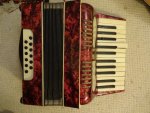londonrob
Newbie
Hi all,
just to say hello and that Im currently repairing a little Alvari 8-bass.

Its all going pretty well so far: Ive replaced all the valves with new vinyl ones on the bass side, and now Im about to attempt the treble side (which has a lot more reeds!)
At some point Ill have to work out why that one key is sticking up, but thats for another post!
just to say hello and that Im currently repairing a little Alvari 8-bass.

Its all going pretty well so far: Ive replaced all the valves with new vinyl ones on the bass side, and now Im about to attempt the treble side (which has a lot more reeds!)
At some point Ill have to work out why that one key is sticking up, but thats for another post!

